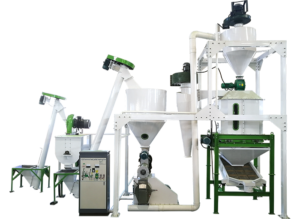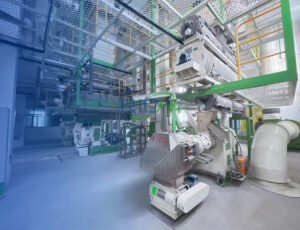
In the dynamic landscape of modern manufacturing, efficiency and consistency are paramount to success. Across various industries, from food and pharmaceuticals to chemicals and construction materials, the need for precise and homogeneous mixing of raw materials is a critical step in the production process. Enter premix mixer machines, specialized equipment designed to blend and combine multiple ingredients with unparalleled accuracy and uniformity, ensuring consistent product quality and optimized production workflows.
The Importance of Premixing in Manufacturing
Premixing, the process of combining and blending raw materials before the primary manufacturing stage, plays a crucial role in various industries. The significance of premixing extends beyond mere ingredient mixing, as it contributes to:
- Consistent Product Quality: Proper premixing ensures that all ingredients are evenly distributed throughout the mixture, resulting in consistent product quality and minimizing batch-to-batch variations.
- Improved Process Efficiency: By thoroughly combining raw materials in the premixing stage, downstream processes can operate more efficiently, reducing the risk of clumping, segregation, or incomplete mixing.
- Enhanced Product Performance: Many products, such as pharmaceuticals, food additives, and construction materials, require precise ingredient ratios and homogeneous mixing to achieve desired performance characteristics.
- Regulatory Compliance: Industries with stringent quality and safety regulations, such as food and pharmaceuticals, rely on premixing to ensure compliance with ingredient specifications and traceability requirements.
- Cost Optimization: Efficient premixing can minimize waste, reduce rework, and optimize raw material usage, leading to cost savings and improved profitability.
The Role of Premix Mixer Machines
Premix mixer machines are specialized equipment designed to facilitate the efficient and accurate blending of raw materials in the premixing stage. These machines offer numerous benefits:
- Consistent Mixing Quality: Advanced premix mixer machines incorporate various mixing mechanisms, such as ribbon blenders, paddle mixers, or high-shear mixers, to ensure thorough and homogeneous mixing of ingredients.
- Scalability and Versatility: Available in a range of sizes and configurations, premix mixer machines can accommodate varying batch sizes and handle diverse raw materials, from powders and granules to liquids and pastes.
- Automation and Process Control: Many premix mixer machines feature advanced automation and process control systems, allowing for precise monitoring and adjustment of mixing parameters, such as speed, time, and temperature, ensuring consistent and repeatable results.
- Containment and Safety: Specialized premix mixer machines are designed with containment features, such as sealed mixing chambers and dust collection systems, to prevent cross-contamination and ensure operator safety when handling hazardous or sensitive materials.
- Ease of Cleaning and Maintenance: Premix mixer machines often incorporate features like quick-release components, smooth surfaces, and specialized cleaning systems to facilitate efficient cleaning and maintenance, reducing downtime and ensuring compliance with hygiene standards.
Related post: https://www.richipelletmachine.com/premix-feed-mill/
Key Components of Premix Mixer Machines
A successful premix mixer machine operation requires the integration of various components to ensure efficient and consistent mixing. The key components of a typical premix mixer machine include:
- Mixing Chamber: The mixing chamber is the central component where the raw materials are combined and blended. It can be designed in various shapes and sizes, depending on the application and the mixing mechanism employed.
- Mixing Mechanism: Premix mixer machines can incorporate various mixing mechanisms, such as ribbon blenders, paddle mixers, high-shear mixers, or tumble blenders, each suited for specific mixing requirements and raw material characteristics.
- Agitators and Impellers: Agitators and impellers are the moving components within the mixing chamber that facilitate the blending and dispersion of raw materials, ensuring thorough mixing and preventing segregation or clumping.
- Feeding and Discharge Systems: Efficient feeding and discharge systems are essential for seamless material handling, ensuring accurate dosing of raw materials and efficient discharge of the premixed product.
- Heating and Cooling Systems: Depending on the application, premix mixer machines may incorporate heating or cooling systems to maintain desired temperature ranges during the mixing process, ensuring optimal product quality and consistency.
- Control and Monitoring Systems: Advanced control and monitoring systems, including programmable logic controllers (PLCs) and human-machine interfaces (HMIs), allow for precise control and monitoring of mixing parameters, such as speed, time, temperature, and batch tracking.
- Containment and Safety Features: Premix mixer machines often incorporate containment features, such as sealed mixing chambers, dust collection systems, and safety interlocks, to prevent cross-contamination, ensure operator safety, and comply with regulatory requirements.
- Cleaning and Maintenance Systems: Efficient cleaning and maintenance systems, such as clean-in-place (CIP) or spray ball systems, are integrated into premix mixer machines to facilitate thorough cleaning and minimize downtime for maintenance activities.
Factors Influencing Premix Mixer Machine Success
The success of a premix mixer machine operation is influenced by several critical factors, including:
- Raw Material Characteristics: The physical and chemical properties of the raw materials, such as particle size, density, flowability, and compatibility, play a crucial role in determining the appropriate mixing mechanism and operating parameters.
- Batch Size and Throughput Requirements: The required batch size and production throughput will dictate the size and capacity of the premix mixer machine, ensuring efficient and cost-effective operation.
- Mixing Efficiency and Homogeneity: The ability of the premix mixer machine to achieve thorough and consistent mixing is essential for ensuring product quality and performance, requiring careful selection of mixing mechanisms and operating parameters.
- Containment and Safety Considerations: Industries handling hazardous or sensitive materials must prioritize containment and safety features to prevent cross-contamination, ensure operator safety, and comply with regulatory requirements.
- Automation and Process Control: Advanced automation and process control systems are crucial for maintaining consistent mixing parameters, enabling real-time monitoring and adjustment, and facilitating batch tracking and traceability.
- Cleaning and Maintenance Efficiency: Efficient cleaning and maintenance procedures are essential for minimizing downtime, ensuring product quality, and complying with hygiene standards, particularly in industries with stringent regulatory requirements.
- Energy Efficiency and Sustainability: Incorporating energy-efficient technologies and sustainable practices, such as optimized mixing processes and waste reduction strategies, can reduce operational costs and minimize environmental impact.
Opportunities and Future Outlook
As the demand for consistent product quality and efficient manufacturing processes continues to rise, the premix mixer machine industry is poised for significant growth, creating numerous opportunities. The future outlook for this sector is promising, driven by factors such as:
- Industry 4.0 and Digital Transformation: The integration of Industry 4.0 technologies, such as the Internet of Things (IoT), big data analytics, and artificial intelligence, will drive the development of smart premix mixer machines with enhanced process monitoring, predictive maintenance, and optimized mixing strategies.
- Sustainable Manufacturing Practices: The adoption of sustainable manufacturing practices, including the use of renewable energy sources, waste reduction strategies, and eco-friendly materials, will become increasingly important in the premix mixer machine industry.
- Customization and Flexibility: The growing demand for customized and specialized products will drive the need for more flexible and adaptable premix mixer machines capable of handling diverse raw materials and mixing requirements.
- Regulatory Compliance and Traceability: Stringent regulatory requirements and the need for enhanced traceability will drive the development of premix mixer machines with advanced data logging, batch tracking, and compliance reporting capabilities.
- Collaboration and Knowledge Sharing: Increased collaboration between equipment manufacturers, end-users, and research institutions will foster knowledge sharing and drive innovation in premix mixer machine design, mixing technologies, and process optimization.
In conclusion, premix mixer machines play a crucial role in driving efficiency and consistency in modern manufacturing processes. By investing in these specialized machines and embracing innovative mixing technologies, stakeholders can contribute to meeting the rising demand for consistent product quality while promoting sustainable practices and economic development. As the world continues to recognize the importance of efficient and responsible manufacturing, premix mixer machines will remain at the forefront of this vital industry, fueling its growth and driving innovation for a more prosperous and responsible future.
For details please contact: Richi Pellet Machine
WhatsApp:86 138 3838 9622
Email:enquiry@richipelletmachine.com






